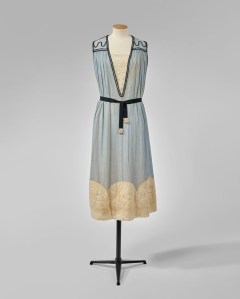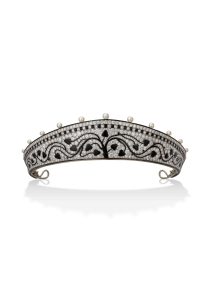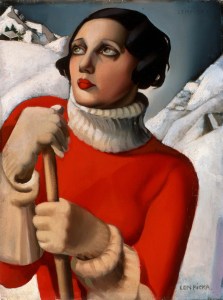A century removed, the latest exhibit at Paris‘ Petit Palais museum sets out to reflect on “Modern Paris, 1905–1925” through the city’s growth as a cultural hub during those years.
Opened Tuesday and set to run through April 14, the expansive exhibit explores the two decades from the Belle Èpoque to the Roaring ’20s, bifurcated by World War I. It touches on all mediums of art from fashion to photography, painting to first forays into filmmaking, architecture and furniture design interspersed with a sobering dose of realism placing the works in the context of conflict.
From the early days of Pablo Picasso in his Montmartre digs, before he relocated to Montparnasse as the artistic heart of the city moved south, the exhibit explores the painterly “gangs” of Paris who influenced the city’s culture early in the century.
The salons they hosted pushed the boundaries of modernity, showing independent artists — as opposed to the government sanctioned ones — and accepted women. Controversial Cubists found a home here, laying the foundation for the modern art movements.
While the exhibit is designed as an overview of all arts in Paris, fashion in many ways sits at the center as it was both a symbol and catalyst for change.
“It was important to include fashion because sometimes we don’t think of it, but it shows the moving of society,” chief heritage curator and head curator Juliette Singer told WWD.
Paul Poiret came into play with his corset-less shapes and dresses which gave women a newfound freedom of movement. The designer opened his own fashion house in 1903, alongside his own Maison Martine, which focused on decorative objects from young apprentices.
Dress shapes and lengths inspired major political and cultural shifts. “The new shapes allowed women to adapt — it was a new way for women to move, to be able to bicycle, dance, go to cocktail parties. It was very important to show how the bodies of women start to free themselves. It was a new way of life,” Singer said.
Jeanne Lanvin, who designed from a “very feminine point of view,” Singer said, also pushed the boundaries in female empowerment. “It’s very modern to note [that] some women are the actor of their own destiny, creating new fashion, taking part in their own life. It was very important to show that it was not just men taking part in fashion.”
Pieces from Madeleine Vionnet and a stunning ruby velvet, studded hood from Madeleine Panizon — created as a nod to the newfound freedom of driving that looks as modern as any runway piece — also feature.
Singer added that it was an “intense” process to secure the dresses for the exhibit, as they are very fragile, but fashion can help people connect to the time period in a more visceral way.
“People sometimes don’t realize fashion is such an important part,” she said. “Discovering the dresses — not in books or photographs, but directly — you can see a small piece [of that time period] and realize how important it was.”

Paul Poiret, Delphinium, 1912. Palais Galliera, Musée de la Mode de la Ville de Paris.
Poiret also created marketing, celebrity dressing and fashion photography in the pre-war years.
Film was still a new medium, but he dressed the stars of the time including actresses Gabrielle Réjane and Mistinguett, as well as hosted lavish celebrity-studded, themed costume balls in his private maison off the Champs-Élysées. The way he deftly used the newest mediums is demonstrated here with produced albums of illustrations.
He collaborated with artist and later Hollywood set designer Paul Iribe on these volumes of dresses against a simple background. The relaxed designs in print were considered scandalous, and, any publicity being good publicity, made his looks a hit. The sketches are on loan from the Paris’ dedicated fashion museum Palais Galliera. Perhaps the original look books, he sent luxury editions of the books exclusively to his best clients. Iribe also designed his advertising and shaped his brand identity, long before such a term was common.
Poiret was also behind the first fashion editorial, on display here, with the black and white photos of models dressed in his collection. Stylized photos showed models posing, while another layout showed one of the first fashion shows with models lined up in dresses, posing with umbrellas, for front and back shots.
His Delphinium dress, a simple silk slipdress in pale blue with a loose black belt, and the Minaret ensemble, a green and silver gown accessorized with harem pants, a feathered turban, embellished hand mirror and jeweled heels with delicate embroidery, are on display here against artworks and decorative touches such as wallpapers and screens
He’d designed the costumes for Jean Richepin’s play of the same name, which was such a hit Poiret decided to make and market similar looks as evening dresses.
Other key pieces showcase the revolutionary simplicity of his works, summer wear in light cottons and colorful gilets with coordinating hats.
His more somber designs of military coats later on are also on display, as artists were activated into wartime efforts. But his design turned out to be impractical — it had no pockets.
Other sections explore the costumes of the Champs-Élysées Theater’s production of Igor Stravinksy’s “The Rite of Spring,” which were simplified versions of dress from Russian folklore that went on to influence fashion. Outfits designed by Nicolas Roerich were loose and gender-neutral, with fanciful headdresses.
Picasso got in on the theater as well, designing Cubist costumes for a ballet set in a fairground. A bucking horse and a 10-foot-tall “manager” bossing the performers around were shapes and squares and odd angles, including a skyscraper on its back illustrating how his work translated to other mediums and influenced fashion of the time.

Tiara, Cartier, 1914, Collection Cartier.
The earliest inkling of Cartier’s now-famous Panther pattern is on display. Though it didn’t come into widespread use until the 1950s, the design originated in 1914.
The famous Tank watch also had it roots in this era, with Louis Cartier creating a men’s watch with a folding buckle. A reflection of the prevailing militaristic mindset, observers thought it resembled the shape of a tank and gave it its name.
Patriotic post-war jewelry from Cartier includes Arc de Triomphe brooches and flags of bleu, blanc, rouge, while the flapper look flouted traditional feminine codes with shorter skirts. A thin silhouette and accessories were ushered in, while the art works of Tamara de Lempicka highlighted fashion while considered seminal works of the Art Deco style. Her Saint Moritz painting is an archetypical example, with a modern woman in a ski sweater borrowed from the boys, with a short bob hair style.

Tamara de Lempicka, “Saint-Moritz,” 1929, Musée de Beaux-Arts d’Orléans.
The 1925 International Exhibition of Modern Decorative and Industrial Arts demonstrated how the city’s fortunes were tied up with fashion, with boutiques and floating houseboat salons built just for the fair. Some of these turned out to be financially disastrous — the wealthy clientele did not want to float — but others, such as the “Pavilion of Elegance” which showcased Cartier and Lanvin, received accolades.
While the 1925 exhibit focused on luxury brands of the time, Singer is careful not to say that Paris’ fortune is tied with luxury. “Fashion can give us ideas and how to show yourself,” she said, citing the de Lempicka painting, which is emblematic of the art of its time period but still feels current. “It’s sophistication mixed with something very natural mixed with something timeless, which is very modern and would still be working now.”
This post was originally published on this site be sure to check out more of their content.








